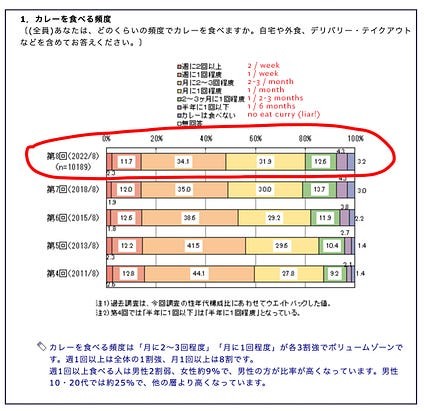Ramen, sushi, sashimi, tempura… the list of iconic Japanese dishes goes on and on. Wagyu beef, udon, soba, miso soup, and a myriad of yaki, don, and age variations flood our minds when we think of Japanese cuisine. But what if the dish that truly defines Japan is hiding in plain sight?
It’s likely that your first culinary experience upon arriving in Japan isn’t what I’m about to reveal. It’s not something intentionally overlooked, but rather a staple often taken for granted, both domestically and internationally. Similar to how many might assume fish and chips is England’s national dish (it’s actually chicken tikka masala!), or pizza representing New York, there’s a more prevalent food item in Japan.
The national Japanese dish is curry.
Let’s dive into some data to back up this claim.
According to a 2022 survey of ten thousand Japanese individuals, a significant 34.1% enjoy curry 2-3 times a month, while another 31.9% indulge once a month. Balancing out the more extreme ends of the spectrum, we can reasonably conclude that the average Japanese person eats curry approximately once every two weeks.
While the overall consumption might have slightly decreased over the years, consider this comparison with onigiri (rice ball), another popular Japanese food:
An astonishing 30.2% of respondents couldn’t recall eating onigiri in the past month! This data suggests that Japanese people consume curry more frequently than onigiri, a fact that may surprise many.
Beyond the numbers, anecdotal evidence further supports curry’s status as a national food.
Consider the fact that children can enjoy curry from a very young age. While sashimi is typically not introduced until around three years old, Anpanman curry, a mild and kid-friendly version, can be found in the baby food section for children as young as 12 months.
Curry’s presence is ubiquitous. You’ll find it on the menu at udon restaurants, pork cutlet restaurants, family restaurants, and canteens. It’s a safe and satisfying option for even the pickiest eaters.
Curry is easy to prepare at home. Simply cook rice, chop vegetables, add protein, water, and a magic block of roux, and you have a complete and delicious meal. It’s a convenient alternative to instant noodles.
The tradition continues through generations: mothers make curry, children eat curry, and those children, in turn, feed curry to their own children.
When envisioning Japanese curry, many people immediately think of Coco Ichibanya, a popular curry chain often referred to as the “McDonald’s of curry.” Their curry is typically smooth, pureed, and served with Japanese rice and a variety of toppings.
While not the cheapest option, a curry rice dish with a fried pork cutlet can cost around 900 yen, comparable to a high-end ramen dish. This price point may be why ramen shop owners harbor a secret envy towards curry shops. Curry allows for more customization, a wider profit margin, and a less rigid business model.
The versatility of curry is another key factor in its widespread appeal. A quick search for “top curry restaurants” reveals an eclectic mix of Indian, Thai, and European-inspired curries. This vast range caters to diverse tastes and preferences.
Speaking of curry restaurants, here’s a glimpse into a personal experience exploring two popular curry establishments: Moritoneri and Afterglow.
Moritoneri, a cozy seven-seater, offers a glimpse into the chef’s dedication to curry. The handwritten menu and intimate setting create a unique dining experience.
Afterglow, on the other hand, boasts a bolder, more chaotic atmosphere with aggressive signage and a focus on intense flavors.
While neither Moritoneri nor Afterglow serves the typical “runny gravy” curry familiar to many, they both showcase the evolution of curry in Japan, incorporating unique textures, pickled elements, and authentic spices.
In conclusion, while a dedicated “curry tour” might not be on your Japan itinerary, consider exploring the diverse world of Japanese curry. It has evolved beyond a simple fast food dish and become a form of culinary self-expression.
If you’re seeking an authentic yet slightly unconventional Japanese experience, look no further than curry. It’s so deeply ingrained in the culture that even the Japanese themselves might not realize it’s their true national dish.
